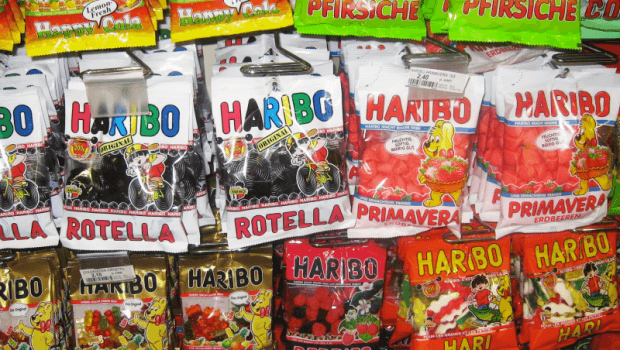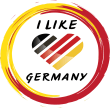
Haribo is a confectionary company based in Germany. It was founded in the year 1920 by Johannes “Hans” Riegel, Sr. with its headquarters at Bonn. The company is one of the biggest manufacturers of sweets that are made out of gummy and jelly in the world.
Among the most popular products produced by Haribo are: gummy bears, other jelly sweets and liquorice. Today, the company has been able to expand world over through its 13 factories in Europe and five in Germany alone. It also has at least one sales office in each of the countries of Europe and as well as one each in Australia and the United States.
The origin of the company’s name is actually from the abbreviated form of – Hans Riegel, Bonn. Moreover, the iconic image of the company was immortalised by Landesmuseum Koblenz who created the module of a travelling exhibition concerning with the history of Haribo in the year 2006.
History
Johannes “Hans” Riegel, the founding father of the company was born on the 3rd of April, 1893 in a town called Friesdorf near Bonn, Germany. He was born to the couple Peter and Agnes Riegel.
Hans Riegel in the due course went on to join a technical school and after he was done he trained as a confectioner. He further worked first with Kleutgen & Meier for a total period of roughly five years. Then he moved on to Neuss and Osnabrück, here he learnt some of the most crucial tricks of the trade concerning production.
As the First World War came to an end, Hans Riegel came in contact with a certain company which was based in the Kessenich district of Bonn. This company was in search for a confectioner and thus Riegel decided to partner up with them. The company was then rechristened as: Heinen & Riegel.
In the year 1920, Hans Riegel decide to go on his own way and took over the company, becoming the sole owner of the enterprise. He also purchased a house in Bergstrasse in Kessenich district and in this house the first production plant was set up. The first few items that he purchased for the company are: a sack of sugar, a marble slab, a stool, a walled-up stove, a copper kettle, and a roller. With all the tools in place and the time being just right, history was about to be made. Riegel, on the 13th of December, 1920 registered the company as HARIBO, an abbreviation of Hans Riegel Bonn.
Another more significant moment in Riegel’s life came in the year 1921 when he married Gertrud. She then after their marriage also became the first employee of the company. A year later, in 1922 the Dancing Bear was invented and this particular product was going to prove the keystone to HARIBO’s forthcoming success. The Dancing Bear was made using fruit gummies and it would later attain fame throughout the world and turn into HARIBO Gold-Bear. In 1923 the first automobile was acquired by HARIBO which was laden with business placards and was meant for deliveries. Prior to this acquisition his wife along with other colleagues would deliver the daily batches on bicycles.
By the time it was 1923, Hans and Gertrud had a son, Hans was born followed by a daughter in 1924 whom they christened Anita and then in 1926 Paul, their third child was born. Another significant year in HARIBO’s history was 1925 when it began to manufacture liquorice products. The first product to be manufactured in this category was the liquorice stick which carried the traditional HARIBO logo which was stamped on it. Following the success of the liquorice stick they created `the Liquorice Wheel. The Liquorice Wheel was another of their products which later would become world famous, almost attaining an iconic status. These were followed by many more products in the same category.
Their business grew steady and strong due to demands which were increasing exponentially. Furthermore, they had nearly 160 employees by the time 1930 arrived along with a sales organisation which comprised of commercial agents who were going to ensure that the whole of Germany could receive supplies from HARIBO on time. In the same decade, sometime around the mid-1930s in-fact they came up with a slogan which said: HARIBO makes children happy. In the early part of the same decade, in the meantime, the main building, where todays’ production facility in Bonn stands, it was constructed.
HARIBO had entered into an agreement with Christian and Eckhof Hansen of Sukkervarenfabrikker Danmark towards the end of 1920s. This was their first venture thorough which HARIBO went outside Germany. Together they both established the HARIBO LAKRIDS A/S in Copenhagen, Denmark.
Just about when World War II was approaching its end HARIBO emerged as a solid medium-sized company employing close to 400 people. Moreover, between the period of 1939 and 1945 as was decreed by the Nazi government, all the factories of the land were mandated to manufacture tanks. This proved to be a considerable setback to the company at the time. HARIBO found it excruciatingly difficult to source raw materials. Another unfortunate setback came about in 1945 when the founding father of the company Hans Riegel passed away. He was fifty two at the time. Gertrud then became the backbone of the company and kept on going strong like the iron lady. Through her guidance the company managed to survive the aftermath of the war that followed and stood its grounds, it then was able to pick up growth and stability. The company rebuilt itself immediately with the reconstruction process commencing with 30 employees. Fortunately the production plant in Bonn remained largely undamaged and everything went well thereon. In any case difficulty still remained in terms of the unavailability of raw materials.
A year later, in 1946, with the release of Hans and Paul Riegel from the prisoners of war camps a new spirit was instilled in the company and their mother Gertrud. They both joined in the company and eventually took over the charge from their mother. Hans’ duties became to oversee the commercial side of the business which included marketing and sales. On the other hand Paul’ side of the work concentrated on the production and related processes.
In the next decade between 1950 and 1960 the company flourished immensely and thus began to expand. Just about five years had passed and the company was now working with over a thousand employees. They were conducting aggressive business and aimed at growth and expansion largely with the sole parable of maintaining quality standards to the highest levels possible. This was further facilitated by the development of new and timely product based ideas along with a marketing strategy which was developed by Dr. Hans Riegel. By 1957 they had accumulated enough capital and decided to buy out Kleutgen & Meier. Kleutgen & Meier was the same company where the founding father of HARIBO Hans Riegel got his first job. Even today you can find HARIBO’s gummies named Monarch being sold across Europe.
With the 1960’s on its way the company decided to tweak its slogan a bit. This time it became: Kids and grown-ups love it so, the happy world of HARIBO. In 1961 it went on to buy out another company and this time it was – Bonera Industrie en Handelsmaatschappij N.V. This company was located in Breda, Netherlands and with the acquisition it became: HARIBO Nederland B.V. 1962 was another significant year which was marked by the first television commercial to be aired on German TV by HARIBO. In 1967 the company bought a sizeable portion of shares in the French confectionery factory Lorette and renamed it as: HARIBO France S.A. Furthermore, in the subsequent years HARIBO went on to acquire more companies across Europe. Another acquisition was in 1985, it was called Ricqles Zan and was located in the South of France and by 1967 this merger resulted in HARIBO RICQLES ZAN with their production site being located in Marseilles, Uzès and Wattrelos. Paul Riegels son, Hans-Jürgen Riegel has been the chairman of this company since 1989.
HARIBO also acquired shares of Dr. Hillers AG, German company this time and by 1967 they took over the company. This acquisition facilitated HARIBO in many ways, they were able to expand into an ultra-modern facility where they could produce all varieties of gummies, liquorice products and chewing gums. They also complete acquired Dunhills of Pontefract, England in 1994. This company had for a very long time been a legend in the production of Pontefract Cakes. Therefore this acquisition was of particular importance.
With the establishment of multiple sales associations and organisations beginning first with Sweden in 1976, then in Austria in 1977 followed by more acquisitions of companies such as Panuli Bonbon Ges. m.b.H. of Linz in 1988 and a French company, Stella from France in 1983. HARIBO reached the Americas in between 1982 and 1989 with their first headquarters in Baltimore, Maryland.
HARIBO also played a considerable role in the unification of Germany. When the Berlin Wall fell they immediately went on to acquire a confectionary factory called WESA in the eastern side. This establishment had started by manufacturing candy gingerbread and chocolate. HARIBO entered the great 1990’s by acquiring an Italian company this time. It was called SIDAS DOLCIARIA S.p.A. They also started to establish their German presence through aggressive advertisements. In this regard they roped in Thomas Gottschalk. Gottschalk was quite a celebrity and an entertainer, and thus became the face of the famous Goldbears along with many other products.
Before the new millennium began HARIBO had made it sure that its presence was there across Europe. They made it sure by establishing a minimum of sales offices in each of the countries.
They have plans to expand further into South America and tapping on to the Asian markets especially China. In Shanghai, China for instance they recently launched a test store.
